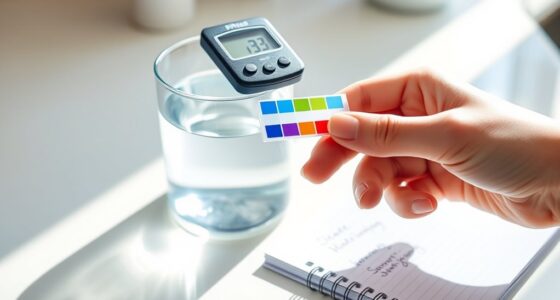To balance alkalinity and hardness in your plunge pool, test the water regularly using reliable kits. Adjust alkalinity between 80-120 ppm to prevent pH swings, and keep calcium hardness between 200-400 ppm to avoid scale buildup or corrosion. Use appropriate chemicals like pH increasers or decreasers, and add calcium chloride or sequestrants as needed. Maintaining this balance guarantees clear, safe water and protects your equipment—continue for more helpful tips to keep everything running smoothly.
Key Takeaways
- Regularly test both alkalinity and calcium hardness levels using reliable testing kits.
- Maintain alkalinity between 80-120 ppm to stabilize pH and prevent fluctuations.
- Keep calcium hardness within 200-400 ppm to prevent scale buildup and corrosive water.
- Use pH adjusters like soda ash or muriatic acid to keep pH in the ideal 7.4-7.6 range.
- Adjust mineral levels gradually with appropriate chemicals, and consider dilution or sequestrants if necessary.

Maintaining proper balance in your pool water is essential for clear, healthy swimming conditions. When it comes to a plunge pool, small in size but big on importance, balancing alkalinity and hardness plays a critical role in ensuring water stays clean and safe. One of the first steps is understanding pH adjustment, which directly impacts how well your pool water resist changes in acidity or alkalinity. Your goal should be to keep the pH level between 7.4 and 7.6. If the pH drifts outside this range, it can cause water to become either corrosive or scale-forming, leading to cloudy water, equipment issues, or skin irritation. To achieve ideal pH adjustment, you may need to add pH increasers like soda ash or pH decreasers such as muriatic acid. Regular testing with a reliable kit helps you stay on top of these changes, ensuring you make timely adjustments.
Mineral control is equally important because minerals like calcium and magnesium influence water hardness, which affects how your pool reacts to chemicals and how comfortable it feels to swimmers. Too much mineral content leads to high hardness levels, making water feel sticky and increasing the risk of scale build-up on your pool surface and equipment. Conversely, low mineral levels can cause water to become corrosive, damaging pool components over time. To maintain balanced minerals, you’ll want to test for calcium hardness regularly—ideally once a week—and keep levels within the recommended range of 200 to 400 ppm. If calcium hardness is too high, you can dilute the water with fresh water or use a sequestrant to prevent scale formation. If it’s too low, adding calcium chloride helps stabilize the mineral balance. Additionally, understanding how water chemistry impacts overall pool health can help prevent costly repairs and maintain a pristine swimming environment.
Controlling minerals and adjusting pH are interconnected processes that require ongoing attention. Proper pH adjustment not only keeps your water safe but also enhances mineral control, preventing scale and corrosion. When you regularly test your pool water and make small adjustments as needed, you’re actively preventing problems before they start. This proactive approach prolongs the life of your pool equipment, keeps the water inviting, and minimizes chemical costs. Remember, balancing alkalinity and hardness isn’t a one-time task—it’s an ongoing process that requires vigilance. By staying attentive to pH levels and mineral content, you ensure your plunge pool remains a revitalizing, crystal-clear oasis for every swim.
Frequently Asked Questions
How Often Should I Test My Plunge Pool Water?
You should test your plunge pool water at least twice a week to guarantee proper chemical balance. Regular water testing frequency helps you monitor alkalinity and hardness levels, preventing issues like cloudy water or scaling. If you notice heavy use or after storms, increase testing to weekly or even more often. Consistent chemical balance monitoring keeps your plunge pool safe, clear, and inviting for every swim.
Can High Alkalinity Cause Skin Irritation?
High alkalinity can cause skin irritation because it disrupts pH stability, making water harsh on sensitive skin. When alkalinity levels are too high, your skin may feel dry, itchy, or irritated after swimming. To prevent this, regularly test and adjust your pool’s alkalinity to maintain balanced water. Keeping alkalinity in the right range helps protect your skin, reduces irritation, and guarantees a more comfortable swimming experience.
What Are the Signs of Hard Water Damage?
You’ll notice signs of hard water damage like mineral buildup on fixtures, which causes spots and cloudy glass. You may also see pipe corrosion, leading to leaks or reduced water flow. Over time, hard water can damage appliances and plumbing, resulting in costly repairs. Keep an eye out for these signs so you can address the issue early, preventing further damage and maintaining your water system’s efficiency.
How Do Temperature Changes Affect Alkalinity Levels?
Have you wondered how temperature fluctuations impact alkalinity levels? When temperatures change, they can cause alkalinity to shift, making it harder to maintain stability. Warmer water typically lowers alkalinity, while cooler water can increase it. These fluctuations challenge your efforts to keep balanced water chemistry, so regularly testing and adjusting your pool’s alkalinity helps ensure water remains safe and comfortable. Don’t let temperature swings disrupt your plunge pool’s perfect balance.
Is It Safe to Swim With Imbalanced Water Chemistry?
You shouldn’t swim in water with imbalanced chemistry, as it can cause skin irritation, eye discomfort, and reduce overall safety. When pH isn’t stable and chemical balance is off, it becomes harder to control algae and bacteria. Always test your water regularly, maintain proper alkalinity and hardness levels, and guarantee pH stability to keep your plunge pool safe and enjoyable for everyone.
Conclusion
So, remember, while balancing alkalinity and hardness might seem like a hassle, neglecting it can turn your pristine plunge pool into a cloudy disaster. Ironically, the very effort to keep your water perfect is what keeps it from becoming a murky mess. Stay on top of your water chemistry, and you’ll enjoy crystal-clear dips—because ignoring it might just make your pool the most unforgettable (for all the wrong reasons) on the block.









